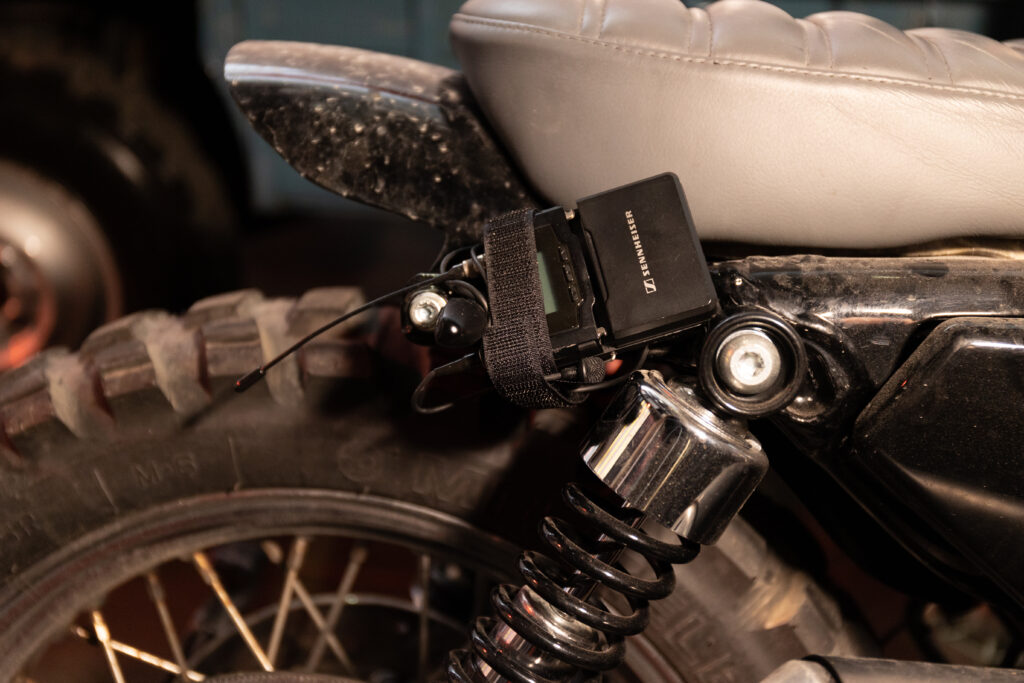

Spectacular stadium performance with Sennheiser microphones
Zurich, November 2022 – The dialect duo “Büetzer Buebe” (www.buetzer-buebe.ch) made Swiss music history with their two major concerts on 19 and 20 August 2022: This was the very first time that a Swiss band had been the headline act at Zurich’s legendary Letzigrund stadium. Marco Pfeuti, better known in Switzerland as Gölä, and Marc Trauffer performed in front of an impressive backdrop of shipping containers – and the tens of thousands of fans in the stadium were ecstatic. Wireless technology from Sennheiser provided outstanding sound, not only in the stadium itself, but also for the live broadcast on Swisscom’s blue TV network.
30 digital wireless channels
Büetzer Buebe, a Swiss German name that roughly translates as ‘Grafter Lads’, certainly put in plenty of hard graft during their spectacular stadium performances – with Digital 6000 wireless microphone systems from Sennheiser. Fifteen SKM 6000 handheld transmitters with MMD 935 and MD 9235 microphone heads were on stage; the lead vocals used MMD 935.
Twenty-three SK 6000 bodypack transmitters were used for instruments, giving the musicians unlimited freedom of movement on the spacious A stage as well as on the B stage that was connected to it via a catwalk. Other and rather unusual sound sources were picked up with bodypack transmitters, too, including a Harley Davidson and a moped, which were miked with Sennheiser MKE 2 clip-on microphones placed close to the exhaust pipes.
The transmitters from the Digital 6000 series sent their signals to 15 Sennheiser EM 6000 two- channel receivers, which were connected to active Sennheiser AD 3700 antennas via two ASA 3000 splitters using low-damping Ecoflex RF cables (GZL 5000 Plus). The transmitter battery packs were recharged at a total of ten L 6000 charging stations.
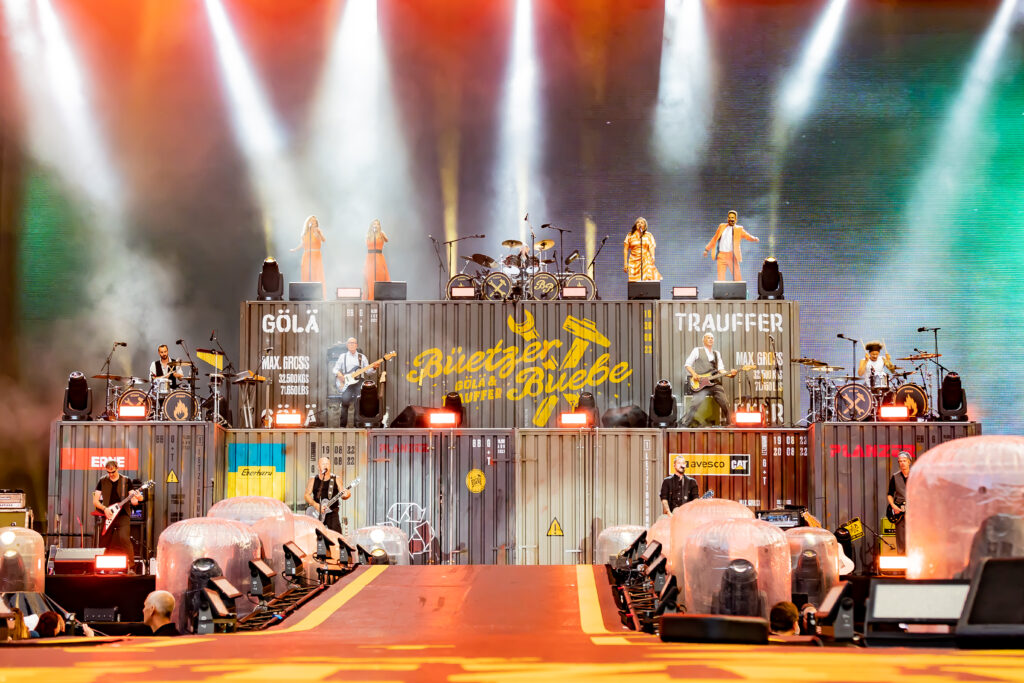
Looks like hard graft: the stage for the Büetzer Buebe (“Grafter Lads”)
(Photo: Thomas Holz)

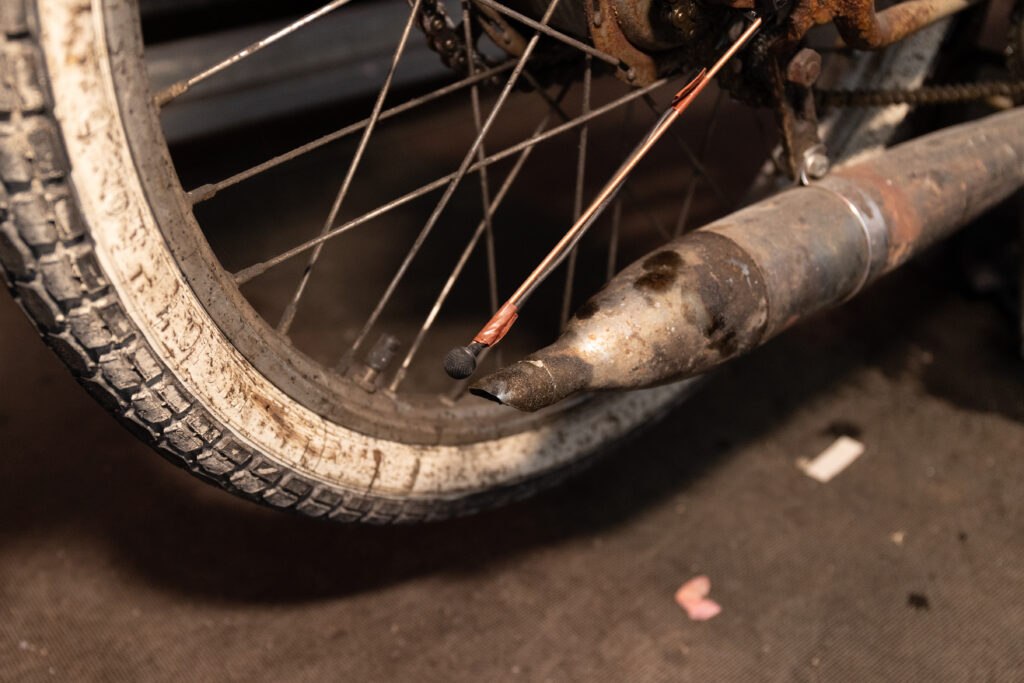
(Photo: Thomas Holz)
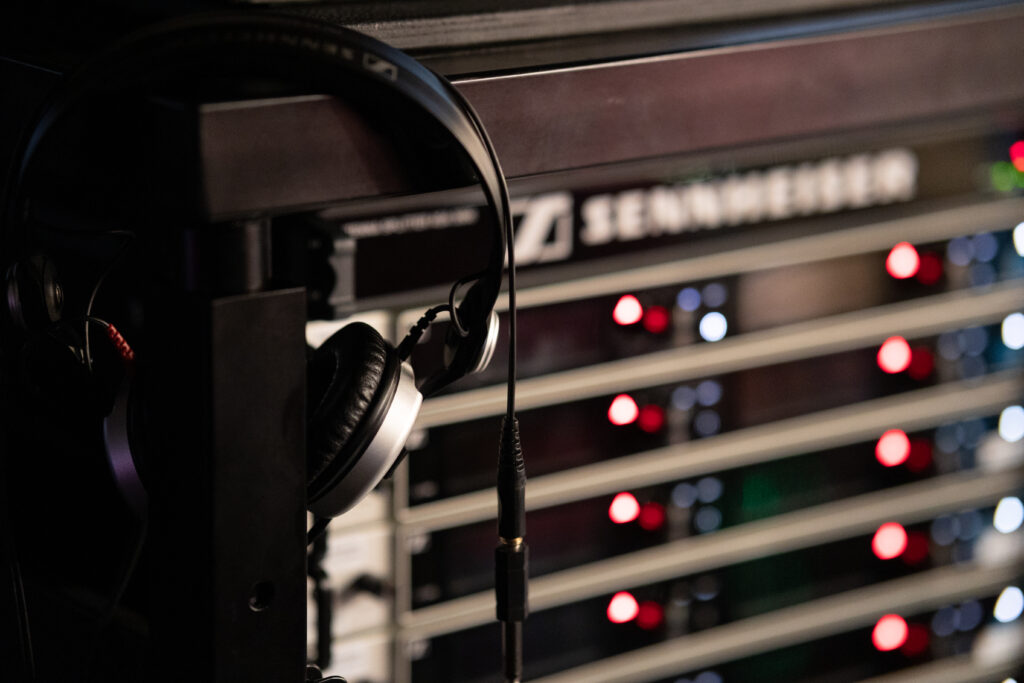
15 EM 6000 two-channel receivers were in use
(Photo: Thomas Holz)
Wireless IEM with the Sennheiser 2000 series
For its wireless in-ear monitoring, this large-scale stadium production relied on a classic analogue system: the Sennheiser 2000 series. A total of 26 channels were transmitted in the GW (558-626 MHz) and BW (626-698 MHz) frequency band and, to handle this large number, the crew had brought along a rack filled with SR 2050 IEM rack-mount twin transmitters. The RF output signals of the IEM transmitters were combined in groups of four with active Sennheiser AC 3200-II antenna combiners and transmitted via low-loss Ecoflex cables to A 5000-CP passive antennas with circular polarisation, which ensured complete coverage of all three levels of the stage.
The IEM equipment was supplemented by a further SR 2050 IEM transmitter at the monitoring console, which supplied the signals for the stage crew and the monitor engineer. The analogue wireless systems were rounded off by two Sennheiser EM 300 G4 receivers, to which the stage manager’s handheld transmitters and a mobile talkback microphone for the crew were assigned.
Sennheiser WSM software was used to supervise and control the extensive wireless set-ups. The Wireless Systems Manager has become firmly established over many years and, at the Letzigrund stadium, it proved to be the perfect tool for the massive task of coordinating and monitoring no less than 82 wireless frequencies in total.
A special feature of the concerts was the backstage tours that took place on the two afternoons and which were managed by Sennheiser. On both days, thanks to precise timing and good organisation, almost 1,000 fans and business partners were given exclusive insights into the action both on stage and backstage.
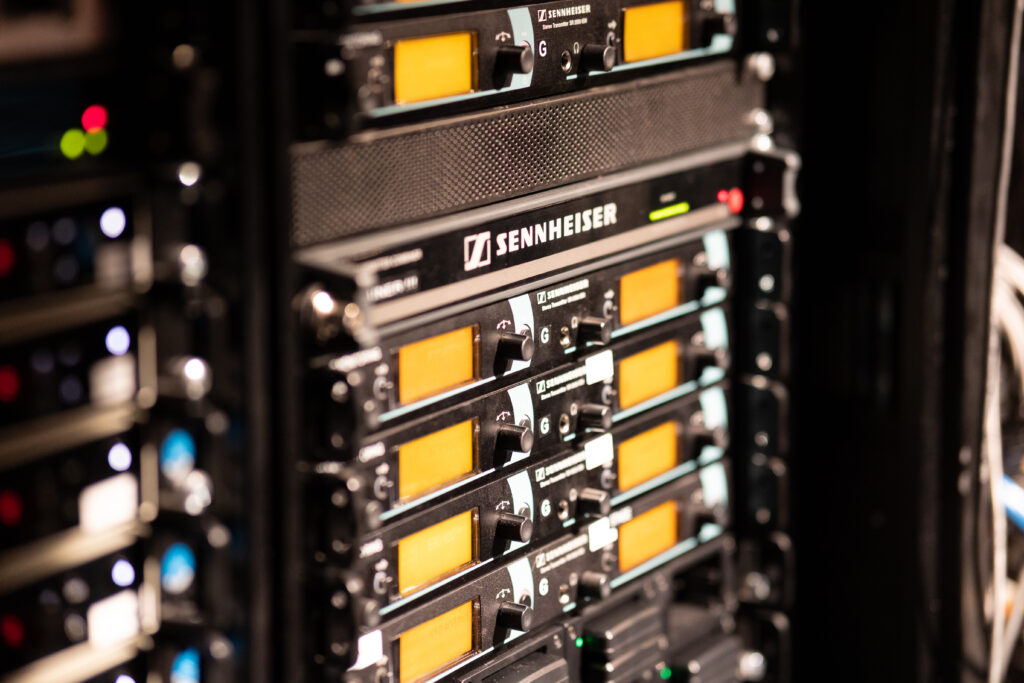
The production crew relied on the Sennheiser 2000 series for in-ear monitoring
(Photo: Thomas Holz)
The FOH perspective
At the FOH console, Rolf Stauffacher had access to around 150 audio channels, due to the large number of musicians involved in the shows. Three drummers, two bass players, five guitarists, two keyboard players and four backing vocalists certainly made sure that the highly experienced audio professional, who is known in the industry as “Dr. Sound” (www.producer.ch), was kept very busy. “Gölä has a regular band with a drummer and percussionist, and Trauffer also has his own band. So if they all join in, you can easily get 17 people and 150 channels all coming together,” says Rolf Stauffacher, commenting on the unusually high number of signals being processed.
As it would have made little sense to reproduce the signals from three drums and five guitars with equal sound levels on the PA system, a tasteful selection was required: “I was able to choose which signals to take and at which levels I should feed them into the sound system,” Stauffacher explains.
“It wasn’t always easy for me to make artistically meaningful decisions. I made multitrack recordings of the rehearsals and then for each individual song I thought carefully about which signals I would like to hear and what I wanted to convey to the audience. That doesn’t mean that I muted individual channels, but that I focused on selected signals more than on others. The result was a powerful “Wall of Sound”, the kind that we are familiar with from Tom Petty, for example. For the drummers, I sometimes took the bass drum signal from only one specific kit and the rest of the signals from all three drummers.”
Stauffacher has been good friends with Marc Trauffer and Gölä for years. “I travelled an awful lot with Marc Trauffer until 2013 and I have been regularly working with Gölä for 15 years now,” says the internationally experienced Swiss sound specialist, whose everyday work includes concerts in stadiums and huge concert venues. “When you’re working in front of an audience of 40,000 people or more, it’s best if you know what you are doing…”, Stauffacher comments with a wink.
Commenting on the wireless equipment, Stauffacher notes: “The guitars were all transmitted wirelessly to make sure the musicians were able to move freely around the 63-metre-wide stage, and this also applied to all the vocalists. There were these huge racks with Sennheiser wireless equipment and, when I saw the incredible dimensions of it all, I politely pointed out to my dear colleagues that I thought they were absolutely crazy… (laughs) I’m always glad when clean signals arrive at my FOH position, which is always guaranteed with wireless systems from Sennheiser. What more can you ask? It works, everything plays, it’s good! It’s something that’s extremely good for my nerves…” (laughs).
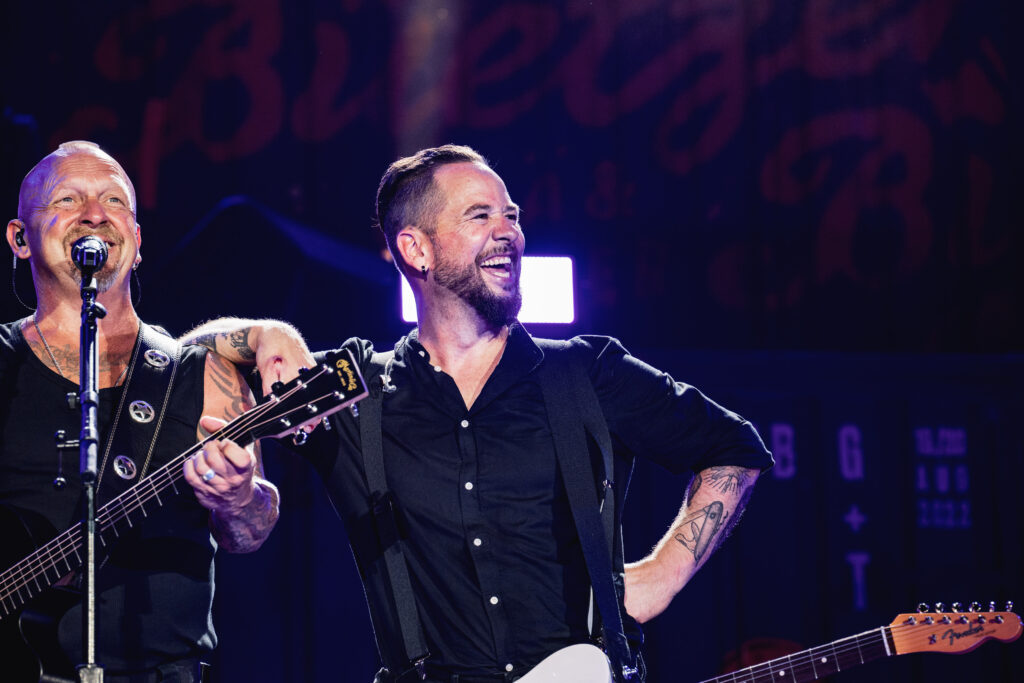
The production crew relied on the Sennheiser 2000 series for in-ear monitoring
(Photo: Thomas Holz)
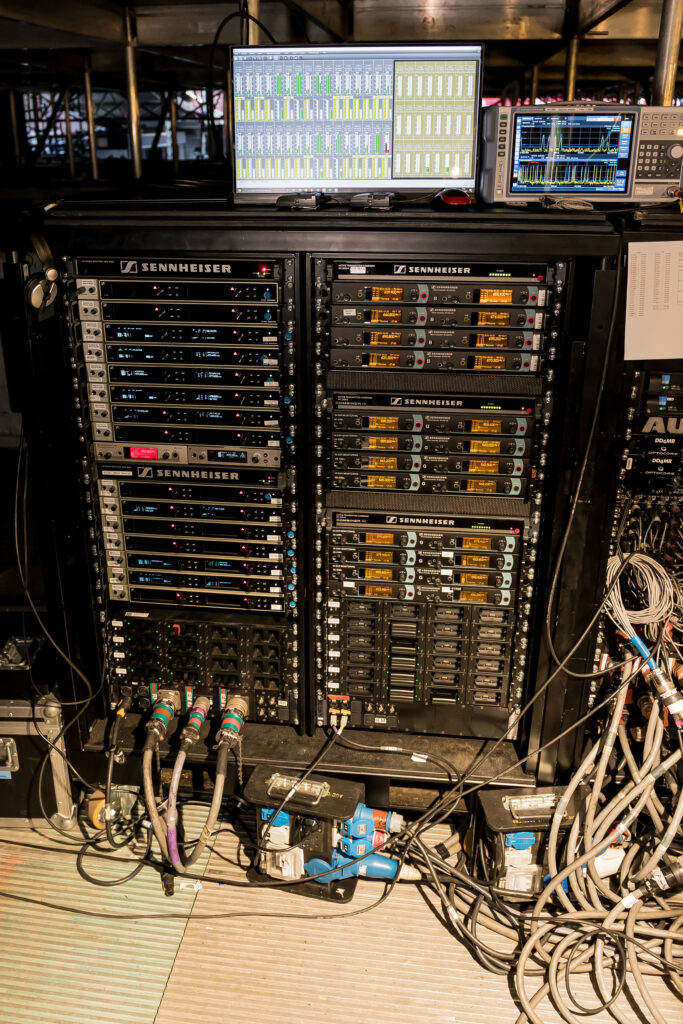
Rolf Stauffacher: “There were these huge racks with Sennheiser wireless equipment and, when I saw the incredible
dimensions of it all, I told my colleagues that I thought they were absolutely crazy…”
(Photo: Thomas Holz)
The monitor perspective
Lars Schläpfer was responsible for the complex monitor mix. “The monitor crews who usually take care of the two bands weren’t available, and so when I was asked to do the two concerts at the Letzigrund stadium, I was more than happy to oblige – after all, it’s a real honour to be able to play a part in a show of this size,” Schläpfer says. “Because I was able to prepare just about everything down to the smallest detail during the rehearsals, the shows themselves were relatively relaxed for me, even though I had a lot of signals to deal with. In Zurich, hardly anyone asked me to make corrections to the set-up – everybody was happy just as it was.”
When asked about the extensive Sennheiser wireless equipment, Schläpfer replies: “We needed an unusually large amount of equipment because we had to deal with a lot of musicians on stage. For monitoring, we used proven products from the Sennheiser 2000 series, while for the transmission channels we exclusively used digital solutions from the Digital 6000 series. It’s always important for me to get a clean signal coming in, and that’s absolutely the case with the digital Sennheiser channels. The latency of the digital wireless channels is just three milliseconds, which is no problem at all in practice.”
Schläpfer continues: “During the shows, the wireless signal transmission worked perfectly. We had a couple of challenges during the rehearsals, but these were quickly resolved due to the highly competent assistance of the Sennheiser support team. They did a fantastic job, I didn’t have to worry about the whole RF transmission situation at all and was able to concentrate entirely on my job at the monitoring console.”
The musicians were each provided with a personal monitor mix; overall, 26 wireless channels were in use, as signals were not only supplied to the performers on stage, but also to several backliners, and others such as Music Director Thomas J. Gyger.
“The drummers were connected by a wired system at their individual positions, while the other musicians were equipped with Sennheiser EK 2000 IEM beltpacks”, Schläpfer reports. “As is usual at big shows, we had conventional wedge monitors and sidefills on stage as well, just in case we needed to use them in an emergency. I ran the wedges at normal levels so that they generated the amount of pressure that performers like – if they rely on in-ear monitors alone, musicians in the pop and rock sector tend to miss a certain foundation that makes them feel good and which is also necessary for a good performance. As the PA system has a cardioid directivity pattern down to low frequencies, the sound on stage felt really crisp and not at all vague, which was a great starting point for my work. I really enjoyed every minute!” In order to perfect the sound for his musicians, Schläpfer had distributed ambience microphones at various positions around the stadium. He used Sennheiser shotgun microphones (ME 64 and ME 66 microphone modules on K6P powering modules) and Neumann KM 184 (barricades, B stage, FOH area).
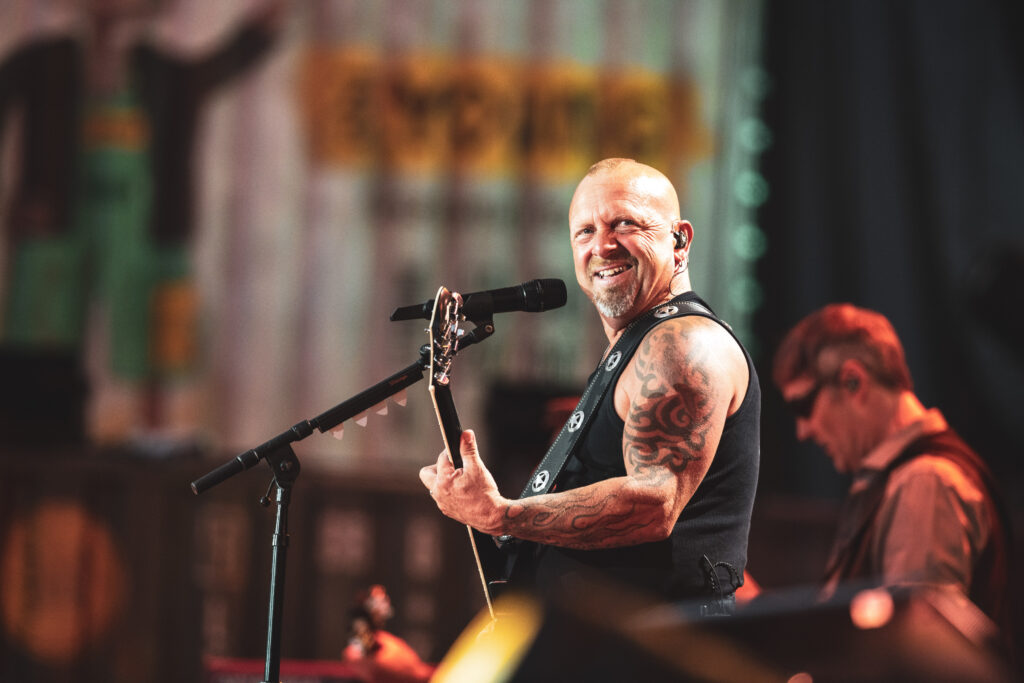
Gölä with the SKM 6000/MMD 935
(Photo: Mood Studios, Adrian Bretscher)
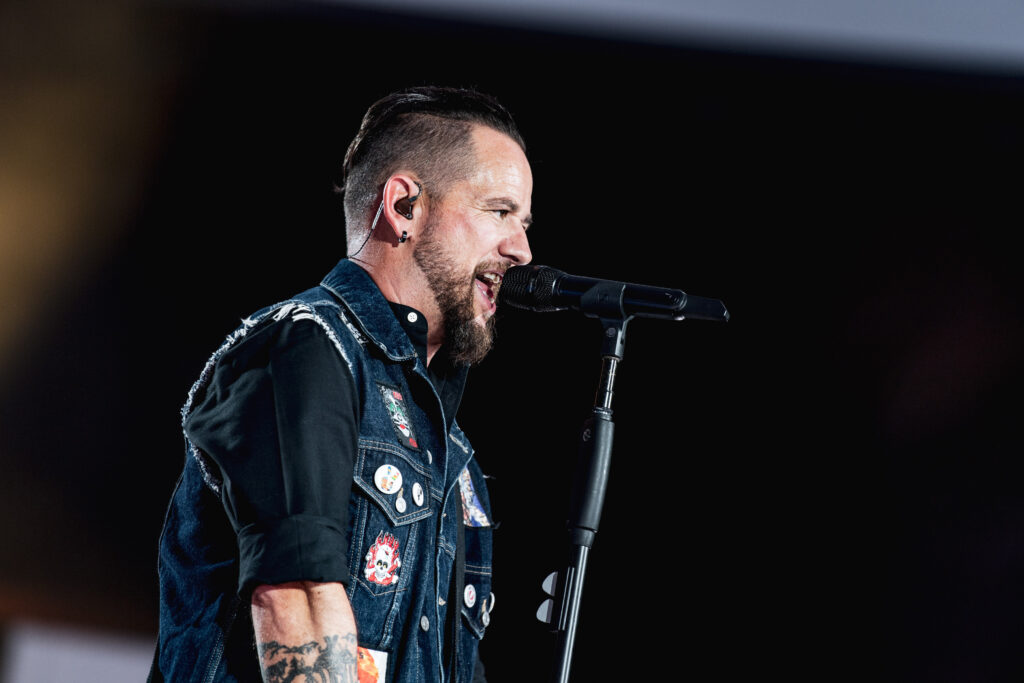
Trauffer also used an SKM 6000 with an MMD 935 capsule
(Photo: Mood Studios, Adrian Bretscher)
The frequency management perspective
Together with his colleague, Gerhard Spyra, Volker Schmitt (Sennheiser Manager Technical Application Engineering, Pro Audio) was responsible for the complex frequency management during the shows. “The Sennheiser Application Engineering team includes around 25 specialists who are spread around the globe in 15 countries to take care of technical support for major productions and events,” Schmitt explains. “The team’s job also involves providing solutions for studios and TV stations, and we often also work in the field of musicals and theatre.”
In August 2022, before the concerts were scheduled to begin, Schmitt and Spyra had the opportunity to analyse the frequency spectrum available in the stadium and its surroundings. As expected, it was confirmed that DVB-T had not been part of “public service” in Switzerland since 2019, which meant that restrictions did not need to be observed in the channels concerned. “You could say that the RF situation was relatively relaxed, although of course it’s always helpful to have a look in advance to see what it’s actually like at the venue itself,” Volker Schmitt comments.
During the rehearsals in Solothurn, Schmitt and Spyra were able to see the impressive stage set (supplied by Planzer and Eberhard) in real life for the first time. The main design elements were 25 shipping containers, which had metal surfaces that could generate unwanted radio wave reflections and impair their transmission. According to Schmitt, however, these reflections “could easily be dealt with in the stadium”. A bigger challenge, however, was the 1,000 m2 LED panel, which, when it was switched on, certainly made itself noticeable in the analysis of the RF spectrum. “In the end, we had to completely revise our frequency planning,” says Volker Schmitt. “My colleague Gerhard Spyra did a fantastic job in this respect because we didn’t have to change a single transmission frequency after that.”
For the Sennheiser systems alone, the planning included 82 wireless channels. Added to this were the frequencies used for the television broadcast (eight channels for wireless microphones and six in-ear wireless channels) that also needed to be taken into consideration. At the Letzigrund stadium, the Digital 6000 system clearly demonstrated its benefits, especially with one of its numerous premium features: “The equidistant frequency grid makes our work much easier,” says Volker Schmitt. “In practice, this frequency grid with its uniform structure works reliably and efficiently and without any intermodulation.”
Volker Schmitt speaks of a “professional, very relaxed production” in which cooperation between all those involved was “extremely pleasant” from the very first day, especially as they were “working hand-in-hand” all the time. Schmitt adds with a smile: “If our work at the wireless console is boring for us during the show, it means that we’ve done a good job and did everything right in advance!”
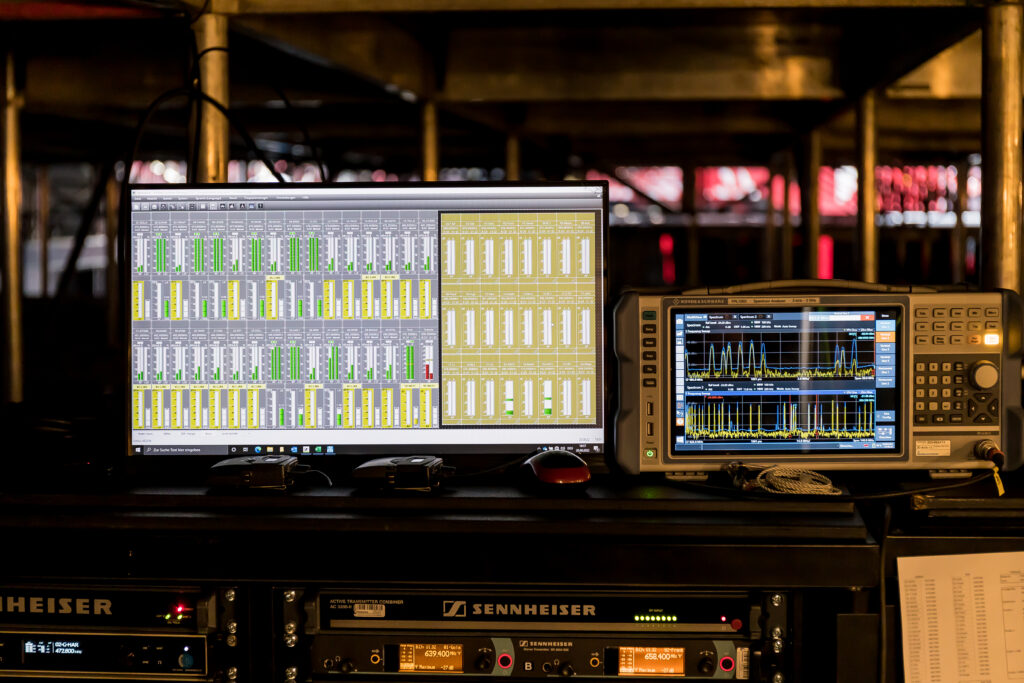
The Wireless Systems Manager software was used to monitor and control the 82 channels at the Letzigrund stadium (Photo: Thomas Holz)
Brilliant finale
After these huge concerts, Büetzer Buebe announced the end of their collaboration as a duo. An extraordinary chapter of Swiss rock/pop history was brought to a close with a brilliant finale at the Letzigrund stadium. On YouTube, one member of the audience summed up the mood among the fans after shows: “Just mega-awesome! Such a shame that Büetzer Buebe are splitting up.”
The two musicians will, of course, now continue their solo careers, which were already successful before this cooperation. Gölä and Trauffer first came together in 2019 to perform a song (“Maa gäge Maa”) for the traditional Swiss-German ESAF sports and culture festival. Swiss media described Büetzer Buebe’s split as “the most harmonious divorce ever”.
The concert-goers will certainly cherish the memories of these two extraordinary evenings for a long time to come. And to keep their memories alive, there is also an album “Büetzer Buebe – Live at Letzigrund”, which immortalises “the best Swiss music festival of all time” (original sound recording promotion) on two CDs and a DVD.
Statements
Chris Kopp was responsible for the overall project management of the Büetzer Buebe concerts on behalf of Sennheiser. He reports: “I can still remember Thomas J. Gyger calling me in 2019 and suggesting that we meet up. ‘I really must show you something,’ he said, but he didn’t give me any details. So without further ado, we met up. In his studio on Lake Thun, Thomas then presented the “Büetzer Buebe” project and asked me if I wanted to be involved (“Bisch däbii?” – “Are you in?”). My first reaction was something like: “Are you crazy – that’s incredible – you must be mad…” But it was clear to me right from the start that nothing like that had ever been done before: a Swiss band as the headline act at the Letzigrund stadium – that’s going to make music history. We’ve definitely got to be there with Sennheiser!”
Chris Kopp accepted the challenge and today, looking back on three eventful years, even with the unexpected setbacks caused by the pandemic, he still speaks of “an amazing journey with a brilliant team”. Kopp: “I know that Büetzer Buebe deliberately chose to use equipment and technology from Sennheiser. Because of their many years of experience with our products, they had the certainty that they could always depend on Sennheiser’s proverbial quality and reliability. Both Marc Trauffer and Music Director Thomas J. Gyger had been using Sennheiser products for years on their tours and have always enjoyed personal and expert support from our team.”
Music Director Thomas J. Gyger, who has made a name for himself outside Switzerland not least because of his work with DJ BoBo, adds: “Products are one thing, but it’s the people behind them that really count. Sennheiser has a highly qualified team and we could rely on them one hundred percent during the planning phase for the shows at the Letzigrund stadium. The Sennheiser team has really distinguished itself through its flexibility and incredible workload – really hard graft, you could say! For us, using Sennheiser solutions was a clear and easy decision to make.”
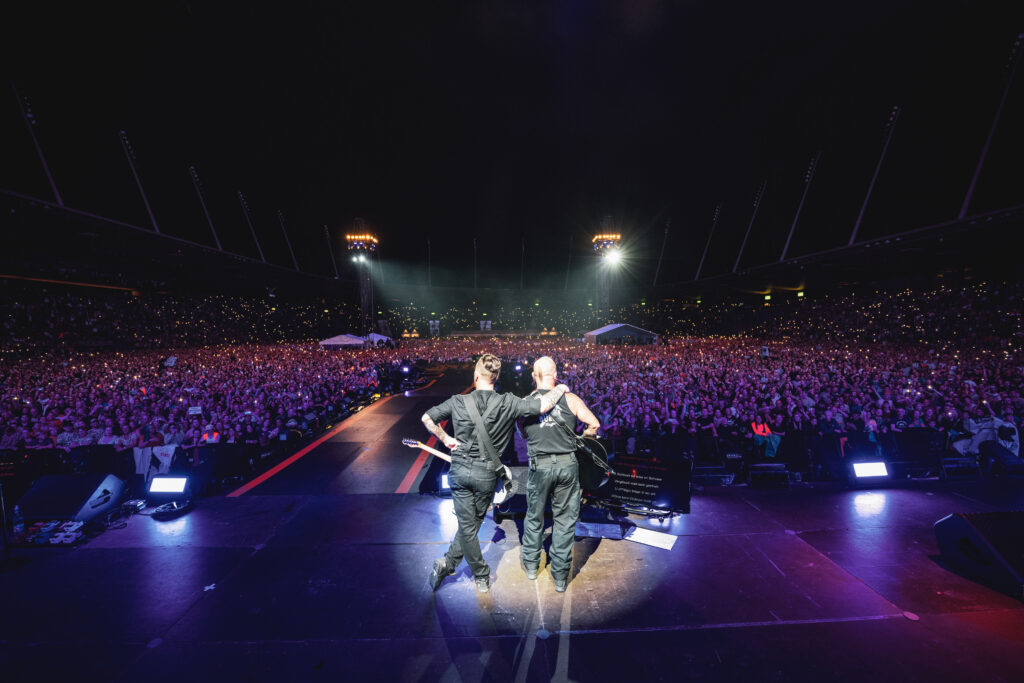
After the two mega concerts, Gölä and Trauffer are going their separate ways
(Photo: Mood Studios, Adrian Bretscher)